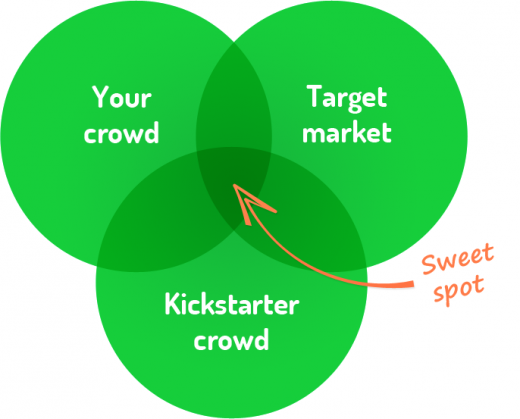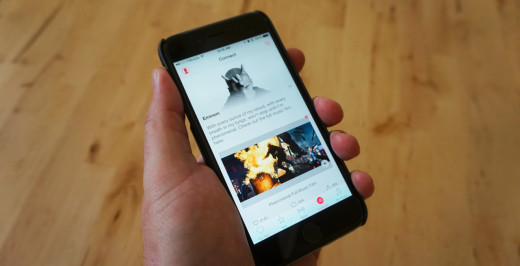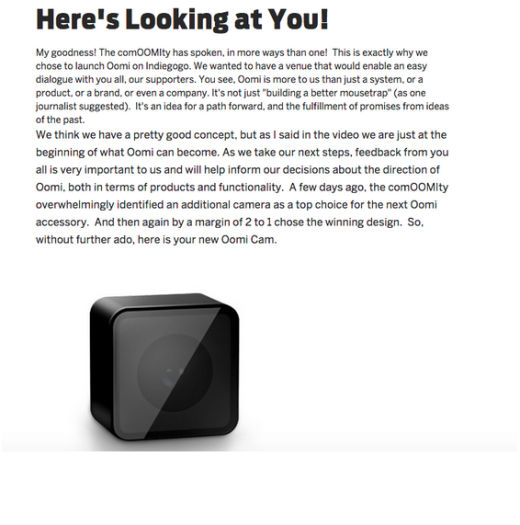
Crowdfunding campaigns have become the go-to funding strategy for new startups and entrepreneurs. Everyone is turning to crowdfunding to get their businesses off the ground. It is oversaturated with ideas and not a given that any particular campaign will succeed.
In the past, getting funding for your idea took a lot of leg work and networking. In today’s world, the ease with which we connect with one another gives startups an opening to share their ideas and get investors with digital videos and social media focused marketing.
During Mass Fidelity’s successful Indiegogo campaign, the combination of traditional and modern strategies was critical to our success and not only helped us reach our goal, but propelled us beyond it 10 times over. I learned that while it is important for new businesses to ride the wave of the latest trends, combining them with tried and true methods leads to enormous success.
Create Momentum
A lot of crowdfunding campaigns generate buzz and excitement on day one, and then fizzle out as they go along. The initial pop at the start of the campaign and wavering contributes to the reason why 60 percent of crowdfunding campaigns don’t meet their monetary goal. This failure can be attributed to many of causes, but one of the biggest is the lack of consistent momentum.
Instead of letting that discourage you, take a lesson from some of the most successful brands on the market. Part of what makes large companies so successful is their ability to see beyond the first day and how they are going to climb the ladder to success. Create a timeline for a gradual release of new features, accessories, or partnerships. It will make current investors more excited about your idea and convince new ones to invest.
Another great way to propel momentum is to get people buzzing about your company. The more coverage you get in the press and social media, the more traffic it will drive to your crowdfunding page. There are a lot of great tools out there, but one of my favorites is HARO. HARO or Help A Reporter Out, is a site that allows reporters to submit queries looking for sources on particular topics.
These are writers who are seeking out information, saving you from sending unsolicited pitches. Find a reporter looking for a source on the topic of your crowdfunding campaign, and you’ve struck gold.
Some of my other favorites include:
- Anewstip – Finding relevant journalists to pitch your great new idea to is tough. Anewstip lets you search and monitor for writers based on what they tweet about. No more guessing or long exhaustive searches, this tool will help you target the right journalists to share your news with.
- Krowdster – Brands itself as the number one app for crowdfunding campaign optimization, crowd building, and promotion. This self service solution lets you be in control of your momentum with tools like analytics, crowd engagement, and optimization to find similarities between you and some of the most successful campaigns out there.
- Buffer – With the popularity of social media, Buffer makes it easier for you to manage posts to Twitter, Facebook, and LinkedIn. Schedule posts for each of your social media profiles and let Buffer take care of posting at the appropriate times. Your followers will get updates about your campaign, while you focus on bringing your idea to life.
- Referral Campaigns – Most crowdfunding platforms have some form of referral campaigns, and these can help you bring in new backers during slower periods in your campaign. Referral campaigns help bring in new pledges by providing perks to backers who get their friends and family to fund the campaign. These perks incentivize the action of going out and promoting the campaign, essentially publicity in exchange for free stuff.
These tools give your campaign a range of options when it comes to finding the right journalists to reach out to and getting your backers to recruit their friends via social media. Having a good balance of tools across multiple platforms ensures that your campaign will maintain a steady stream of pledges.
Have a Captivating Video
Traditionally, a solid demonstration for meetings with journalists, media outlets, and investors, gives your product validation and can help generate recommendations from leaders in your industry. People like to touch, feel, and see what you’re talking about and a great demo gives them that opportunity.
With crowdfunding campaigns, your video is your demo. Since you can’t go around to every one of your potential backers and demo your product, app, or service, your video serves as a tool to let your investors experience your product from the comfort of their homes.
What will set you apart from the competition, and keep you in the forefront of a journalist’s mind, is whether your product can really do what you say it does. When I went around to demo, people were surprised by what my product could do and recommended it to their followers and readers. It wasn’t enough for me to say what the product did, people needed to experience it.
A crowdfunding video can make or break your campaign, and knowing that can be incredibly daunting. What can make the process easier and less stressful is sticking to what has worked for other campaigns. Do your research and see how other videos demonstrate their product, utilize time, and describe what they are doing.
A great example of a well done video is Sensibo. The video is simple and takes place within a single room, but what makes it one of the best videos is how well it demonstrates the product and its sense of humor. Sensibo’s product is exciting enough to have done a video that simply showed backers how to use it and how it could change their lives.
Sensibo used Tross Creative House to produce their video, but if you don’t have the budget yet to hire a production team, there are plenty of apps and software tools that can help you professionally edit your video. Magisto is regularly at the top of the best video editing tools for mobile. What makes this route especially frugal is that you can shoot the video directly from the smartphone (iOS or Android) you already own and edit there as well.
No need to purchase additional equipment. If you like editing on your computer, upload videos to Magisto’s website and edit from there. It’s easy to use for even the most novice video editor and will be sure to help give your crowdfunding video an extra boost.
Other great editing tools:
- Kinemaster – Android
- iMovie – iOS, OS X
- Lightworks – Windows, Linux, Mac OS X
- Filmora – Windows
- NCH Videopad – Windows, Mac OS X, iPad, Android, Kindle
Communicate with your Investors
Crowdfunding campaigns by design mean you never meet your backers face-to-face. For an investor, there is a certain comfort about looking someone in the eye and hearing exactly what they are planning to do with your money. Investor meetings with charts and graphs on a company’s latest progress are traditionally how investors stay up-to-date on their investment.
In the world of crowdfunding, it’s important to stay in constant communication with your backers, and in the right way. For example, if you’re going to miss your deadline, your backers don’t want to hear about events you’re attending or the marketing that you’re doing. People get tired of brand exposure, and quickly. Update your backers on the status of your product, app, or platform to show them that they didn’t invest in nothing. They need to know that what you promised them is coming.
It’s about more than just updating them, you need to engage them. Social media is the perfect place to post questions and start discussions with your loyal fans. Ask your Facebook followers what they think your next accessory should be or next available color. Start a trending topic on Twitter and get your fans tweeting about you. Another great way to engage your backers is to meet them in person. Like I previously mentioned, you can’t meet them all, but setting up meet-and-greets and demos for your backers builds trust.
There is nothing like meeting someone face-to-face to give you the security that you’ve backed a good product. Consumers like to be heard and the more opportunities you give them to voice their opinions, the more likely they are to feel a strong connection to your product and recommend it to their followers.
One campaign that did an excellent job of staying in contact with backers is Oomi, a Chicago-based company that’s redefining the smart home experience. They reach out to their backers every couple of days to give them an update on what they are doing behind the scenes, offer flash sales, and show off brand new accessories. These updates let backers know that Oomi is working hard to bring their product to life and get it into their backers’ hands. Additionally, Oomi is responding to comments within hours of them being posted, which gives backers and potential ones the feeling that they matter.
Here’s a great example of one of Oomi’s updates to backers:
Stick to your Budget
Crowdfunding campaigns are known for great incentives that help sweeten the deal for generous backers. However, if you don’t factor them into your overall budget, your crowdfunding campaign could do more harm than good. The last thing you want to do is bankrupt your business before it even gets off the ground, or worse, do extremely well but don’t have enough money to market the product post crowdfunding campaign.
Traditional incentives are calculated in terms of return on investment that are well researched and based on long-term goals of the company. Startups launching crowdfunding campaigns need to be business savvy and know their breakeven points and fine points around expenses. Additionally, when pricing out incentives a $50 difference in pricing, while seemingly insignificant, can make or break consistency and continued growth for your business.
Backers need to see attainable perk levels, which is why a lot of campaigns start from as low as $5 and offer what they can at that price, even if it’s nothing but a big thank you. Companies that don’t allow for investors to come in at a low level, miss out on the opportunity to bring in extra revenue. Campaigns that start in the $200 range put themselves at a disadvantage because a lot of people don’t have the money to enter at that level, missing a huge opportunity, and inevitably failing to make their goal.
It has been concluded that the $25 tier receives the most contributions and can account for a significant portion of your funding. Start there when you are putting your tiers together and decide how to expand above and below that pricing. Ouya, a new kind of video game console, raised nearly $8.6 million during their Kickstarter campaign. Below is part of their successful tier structure that helped them raise nine times their funding goal:
$10 – Reserve your username
$25 – Reserve your username and get a founder emblem emblazoned next to it
$95 – Get an Ouya and controller (early bird)
$99 – Get an Ouya and controller
$140 – Limited edition brown brushed metal finish Ouya (last week of campaign only)
$225 – Get an Ouya, 2 controllers with your username etched into them
There are a lot of great places to get tips on how to structure your perks aside from researching old campaigns. The crowdfunding platforms themselves are great resources for tips and advice on how to be successful. Indiegogo did a video with their crowdfunding experts to engage with the community on how to structure their perks tiers. These are the true experts since it’s their business to help you get funded.
Try, Try Again
Persistence is an age-old business strategy. If you aren’t successful the first time around, pick yourself up, figure out where you went wrong, and try it again. It’s fairly common in crowdfunding for a failed campaign to be re-launched several months after its first go-around.
Coolest Cooler is a great example of this. The campaign initially launched on Kickstarter in 2013. After it failed to raise enough funds, they went back to collect themselves and re-launched in 2014. Their second campaign was one of the most funded projects in 2014, reaching 26x their funding goal and raising a total of $13 million.
So how did they go from a failed campaign to a record breaking one? Coolest Cooler completely redesigned their product to make it sleeker and more visually appealing. In addition to a better appearance, the team added in brand new features like a waterproof bluetooth speaker, USB charger, and an LED light built into the lid for use at night. Coolest Cooler changed their rewards by lowering prices to make it more attainable for backers to support them. Finally, they used higher quality photos that made them look like a serious company that is ready to produce a great product.
When analyzing your first campaign, use this guideline to think critically about crucial mistakes and how you can correct them for the re-launch:
Use Your Backers
Like Coolest Cooler, the key to success the second time is analyzing what went wrong the first time around. Your backers can be a great resource for giving you feedback on what could be better and a boost of confidence for launching a second campaign. Take time to read through every comment and remind yourself what your backers were asking for, what kinds of questions they had, and what suggestions they gave you for new features and accessories. This feedback is the best foundation to rebuild
Check Your Timing
Timing can be a crucial mistake in your campaign if you don’t plan wisely. When it comes to your launch date, try to find times when people have a surplus of cash and are more willing to spend some of that extra money to fund your campaign. The holiday season is swamped with retailers and major brands pushing their products to consumers. Stay away from this time of year if you want to see success when you relaunch your campaign. If your target market is in the US, try picking a date around the end of tax season when everyone gets their tax refunds. That money from Uncle Sam might be the additional push you need to get more backers.
Change Your Platform
Consider changing your crowdfunding platform for your re-launch. If you see you’re not having success on one, it might be because you’re not reaching the right audience. A lot of campaigns have success switching from Kickstarter to Indiegogo, and vice-versa. Each platform reaches a different audience, and it’s important to ask yourself before settling, who do you want to reach and where do they live? This will help you narrow down your options and come to a more suitable platform.
Also check out these additional resources, which will help you to craft the perfect campaign and learn from others out there:
- Crowdfunding Hacks – Clay Herbert, a startup advisor who has helped his clients raise over $30 million on Kickstarter and Indiegogo, offers readers tips to help launch and fund their dreams.
- CrowdCrux – Run by Salvador Briggman, CrowdCrux is a blog to help people run successful crowdunding campaigns. His posts have been cited on major news networks like CNN and the New York Times.
- Crowdfund Insider – This blog take a different approach to crowdfunding blogging. Functioning more like a news and information site on how the financial industry and how the crowdfunding trend is disrupting it.
- CrowdFundBeat – A UK based blog that provides news, information, events, and resources for crowdfunding. The site covers crowdfunding news in the US, UK, Canada, Germany, and Italy, written by crowdfunding experts and professionals.
It’s true that the world of business is changing and keeping up with the ever evolving environment is crucial, but that doesn’t mean entrepreneurs can’t learn a thing or two from more traditional strategies. Going back to the basics can give your campaign a leg up in the competition and beat the crowdfunding odds on your way to growing your business.
Read Next: Etsy is piloting a crowdfunding initiative called Fund
Image credit: Shutterstock
Get the TNW newsletter
Get the most important tech news in your inbox each week.














